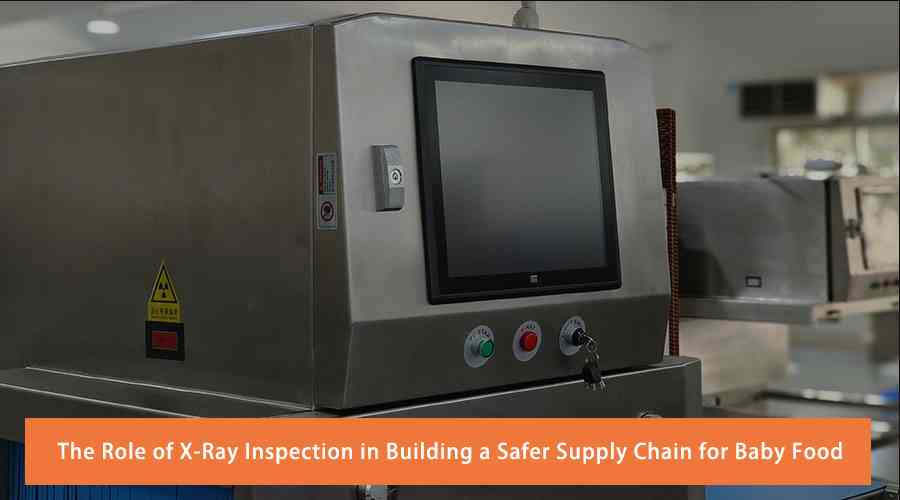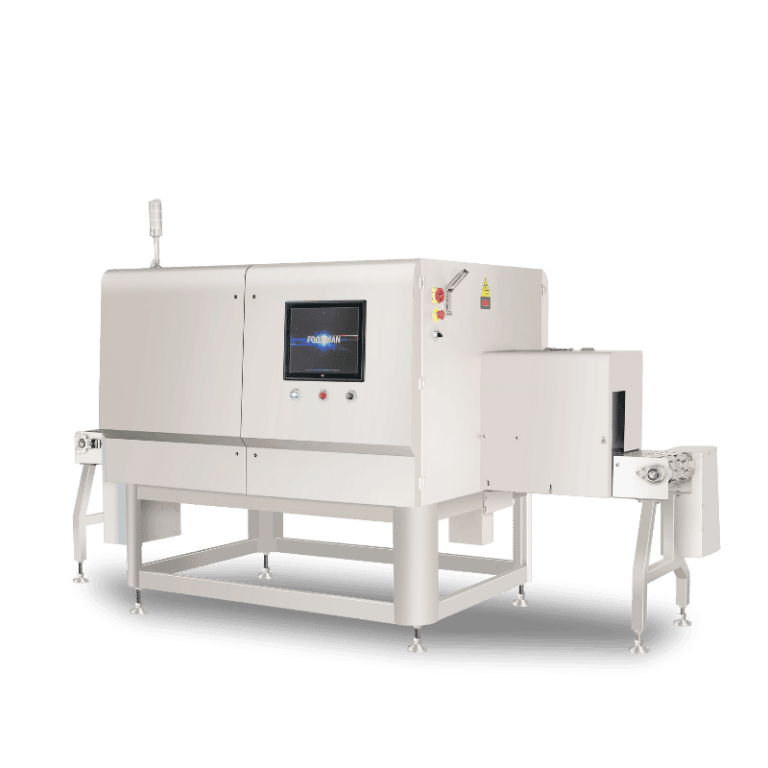Introduction
In today’s health-conscious world, food safety is a top priority, especially for infant nutrition. As demand for food quality and transparency grows, baby food manufacturers rely on X-Ray inspection solutions. Modern X-Ray inspection systems detect tiny foreign bodies like glass, metal, or stone without damaging products. These X-Ray inspection machines ensure strict food X-Ray inspection standards, protecting the most vulnerable consumers—infants.
Why Food Safety Is Critical in Baby Food
Infants have delicate immune systems, making them highly vulnerable to contaminants. Even small foreign objects can cause serious harm. Therefore, baby food must be free from contaminants and produced under strict hygienic conditions to ensure safety, brand trust, and regulatory compliance.
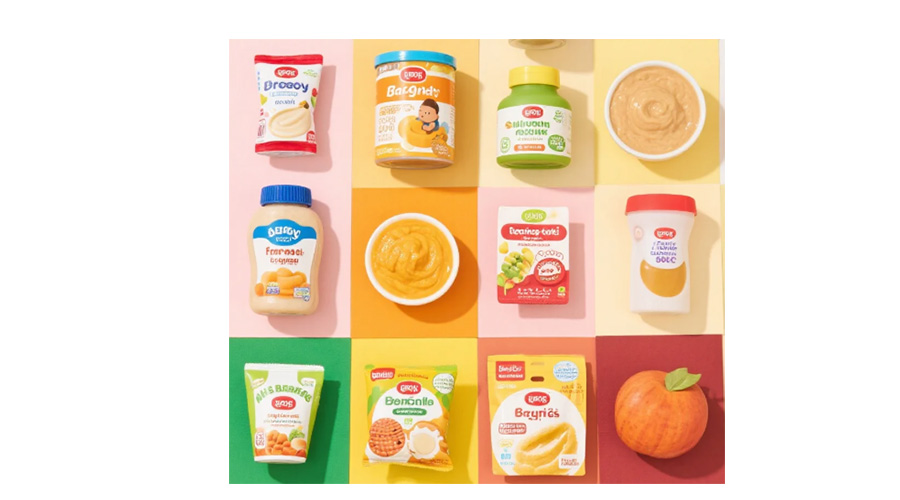
Rising Demand for Safer, More Transparent Supply Chains
Consumers want not only safe baby food but also clear information about ingredient sourcing and safety measures. Complex supply chains require advanced, real-time inspection technologies integrated into production for full transparency and reliability.
X-Ray Inspection as a Technological Answer to Quality and Safety Concerns
X-Ray inspection systems identify foreign materials regardless of packaging or moisture. They operate quickly and accurately, ideal for sensitive products like fruit purees and powdered formula. AI-enhanced X-Ray inspection machines reduce false alarms and improve quality insights, making them essential for safer, more efficient baby food production.
Unique Challenges in Baby Food Production
High Sensitivity of the End Consumers
Babies are especially vulnerable to physical contaminants due to their delicate and developing immune systems. Even the smallest foreign particles—such as tiny glass fragments or metal bits—can cause severe health risks including choking, allergic reactions, or infections. This makes the safety requirements for baby food far more stringent than for other food products.
Stringent Industry Regulations
Baby food production is tightly regulated by global safety authorities, including the FDA in the United States, the European Union’s food safety agencies, and China’s CFDA. These agencies enforce strict standards that often follow a zero-tolerance policy for any contamination. Manufacturers must comply with these rigorous regulations to ensure their products are completely safe for infants, protecting both the children’s health and the brand’s credibility.
How X-Ray Inspection Helps Mitigate Risks
Detecting a Wide Range of Contaminants
X-Ray inspection technology offers a powerful solution to one of the biggest challenges in baby food production: identifying a broad spectrum of potential contaminants. A modern X-Ray inspection system can detect metals (including ferrous, non-ferrous, and stainless steel), glass shards, stones, bones, and even hard plastics that might accidentally enter the product during processing or packaging. What sets the X-Ray inspection machine apart from traditional metal detectors is its ability to identify non-metallic contaminants, which are often invisible to conventional methods. Moreover, the system can perform these inspections even when products are fully sealed in their packaging, preserving the product’s integrity while ensuring safety. This comprehensive detection capability is vital for maintaining the highest standards of food quality, minimizing risks, and protecting infant health.
Non-Invasive and Real-Time Monitoring
One of the key advantages of deploying an X-Ray inspection system in baby food manufacturing is its non-invasive nature. These machines enable inline inspection during the production process without damaging or opening the packaging, which is crucial for maintaining sterile conditions and product freshness. This real-time monitoring allows manufacturers to catch contaminants immediately, reducing the risk of unsafe products reaching the market. Furthermore, X-Ray inspection machines are versatile and can handle a wide variety of baby food products—from solid snacks and cereals to semi-liquid purees and powdered formulas. By integrating food X-Ray inspection seamlessly into the production line, companies not only enhance food quality and safety but also improve operational efficiency, reduce waste, and meet stringent regulatory requirements.
Enhancing Supply Chain Transparency and Efficiency
Inspection at Critical Control Points
To ensure food safety and maintain consistent product quality, especially in sensitive sectors like baby food, it’s essential to implement inspection mechanisms at multiple Critical Control Points (CCPs) throughout the supply chain. X-Ray inspection systems play a vital role in this strategy.
Raw Material Screening: The first line of defense starts with inspecting incoming raw materials. Whether it’s grains, fruits, or powdered ingredients, X-Ray inspection machines can detect foreign contaminants before the materials even enter the processing phase. This early intervention prevents the spread of impurities downstream and significantly reduces the risk of product recalls.
In-Process Inspection and Final Product Check: During the manufacturing process, in-line X-Ray inspection machines conduct real-time scanning of semi-finished products. This ensures that contaminants introduced during processing, such as metal shards from machinery or fragments from packaging materials, are detected and eliminated. Before packaging, a final inspection guarantees that only compliant, contaminant-free baby food products move forward to distribution.
By placing X-Ray inspection systems at these CCPs, manufacturers can intercept quality issues at the source, enhancing both product safety and operational efficiency across the production line.
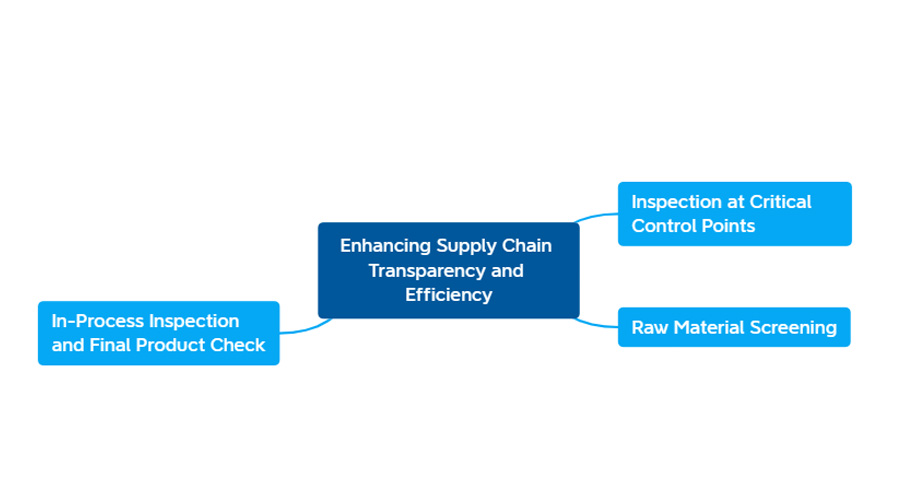
Supporting Traceability and Recall Management
In today’s global supply chains, traceability is not just a best practice—it’s a necessity. When dealing with high-risk products like baby food, the ability to trace and respond to issues quickly can prevent widespread recalls and protect consumer trust.
Modern X-Ray inspection systems support traceability by automatically generating and storing detailed image records and inspection data for every item that passes through the line. These high-resolution images provide visual proof of compliance and can be linked to batch numbers, timestamps, and production lines, creating a robust digital audit trail.
In the event that a safety issue arises, manufacturers can quickly isolate and identify affected batches, minimizing disruption and protecting their brand. The availability of this data also facilitates smoother audits, improves supply chain accountability, and aligns with international safety standards such as HACCP, BRC, and ISO.
Ultimately, X-Ray inspection systems not only safeguard food quality but also serve as a foundational tool for efficient recall management, transparency, and regulatory compliance throughout the baby food supply chain.
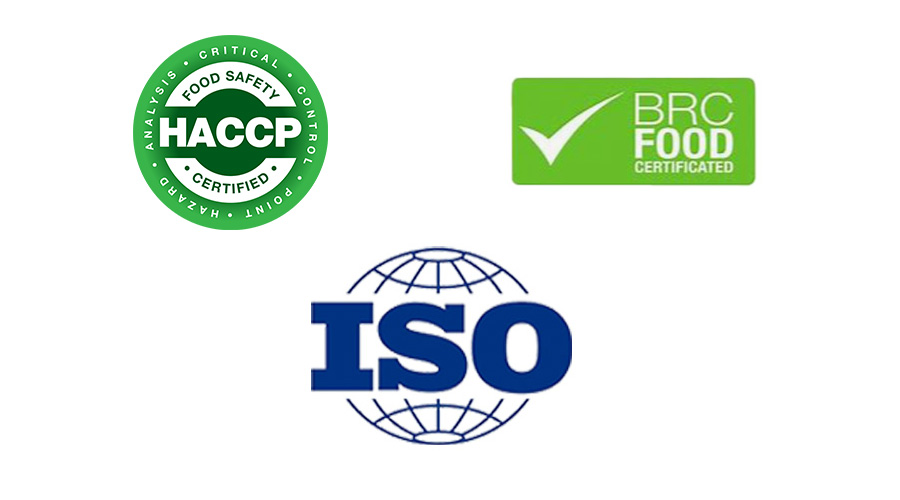
Case Study
A Baby Food Processor Implementing X-Ray Systems at Multiple Points
A leading baby food manufacturer in Asia, known for its fruit purees, cereal mixes, and ready-to-eat meals, faced increasing scrutiny from retailers and regulators regarding contamination control and traceability. Although the company had basic metal detectors in place, they struggled to detect non-metal contaminants such as glass fragments, hard plastic, and small stones—especially in products with metallic or multilayer packaging.
To address these challenges, the company decided to upgrade its inspection line with advanced X-Ray inspection systems at multiple critical points across production:
Raw Material Reception: X-Ray inspection machines were deployed to screen bulk deliveries of grains and fruits before storage, preventing any contaminated raw materials from entering production.
Mid-Process Inspection: During mixing and filling, inline food X-Ray inspection systems were integrated to scan semi-processed purees and powders for dense foreign bodies without halting the production line.
End-of-Line Quality Control: Finally, finished and sealed packages were subjected to X-Ray inspection, ensuring that no contaminant had entered during the packaging stage and that each unit met the company’s strict food quality standards.
By strategically positioning X-Ray inspection machines throughout their process, the company created a multilayered safety net that significantly reduced the risk of contamination slipping through.
Benefits: Reduced Customer Complaints, Improved Audit Scores, Faster Quality Assurance
After the implementation of the X-Ray inspection systems, the company observed several measurable improvements across its operations:
Reduced Customer Complaints: Within six months, the rate of consumer complaints related to physical contamination dropped by over 90%. Retail partners also reported increased confidence in the brand’s commitment to baby food safety.
Improved Audit Scores: Third-party audits by both domestic and international certification bodies noted substantial improvement in safety protocols and traceability. The company achieved higher scores in categories related to hazard detection, CCP validation, and documentation.
Faster Quality Assurance: With real-time imaging and automated rejection capabilities, the X-Ray inspection systems significantly accelerated the QA process. The production team could immediately isolate problematic batches and resolve anomalies without halting the entire line.
Moreover, the digital records generated by the X-Ray inspection systems enabled the company to conduct detailed trend analysis, optimize process settings, and quickly demonstrate compliance during regulatory inspections.
This case highlights how the right investment in X-Ray inspection technology can not only safeguard food quality for vulnerable consumers like infants but also deliver tangible business value through operational efficiency, improved brand trust, and enhanced regulatory readiness.
Conclusion
X-Ray Inspection Is Not Just a Quality Control Tool — It's a Brand Protection Asset
In the high-stakes world of baby food production, X-Ray inspection systems are far more than technical add-ons; they are strategic investments in brand integrity. As consumers become increasingly aware of food safety issues and demand accountability from manufacturers, the ability to guarantee contaminant-free products becomes a direct reflection of a brand’s values and reliability.
Unlike traditional inspection technologies, X-Ray inspection machines can detect a wide spectrum of contaminants—including glass, stones, bones, and dense plastics—that would otherwise go unnoticed. By minimizing the risk of recalls, protecting infants from harm, and reducing the chance of negative publicity, these systems act as powerful safeguards for both food quality and corporate reputation.
It Ensures a Safer, More Transparent Baby Food Supply Chain
From raw ingredient screening to final product inspection, X-Ray inspection systems play a vital role in creating a fully traceable and transparent supply chain. Every inspected product is logged with detailed image records, allowing for better traceability, audit readiness, and rapid response in the event of quality concerns.
This kind of end-to-end visibility is essential not only for regulatory compliance, but also for winning the trust of parents, caregivers, and distribution partners. In a market where confidence is everything, food X-Ray inspection provides the data-driven transparency modern consumers expect.
A Must-Have Investment for Manufacturers Prioritizing Infant Health and Consumer Trust
Given the heightened vulnerability of infant consumers and the uncompromising standards of today’s regulatory landscape, adopting X-Ray inspection technology is no longer optional for serious baby food manufacturers—it’s essential.
The combination of non-destructive inline inspection, high-speed performance, and advanced contaminant detection positions X-Ray inspection systems as must-have tools for any producer aiming to lead on food safety and quality. For manufacturers that prioritize infant health, long-term brand equity, and consumer loyalty, the message is clear: investing in X-Ray inspection machines is an investment in trust.
FAQ
Q1: Why is X-Ray inspection necessary in baby food production instead of just using metal detectors?
A: Traditional metal detectors can only identify metal-based contaminants. However, baby food may also be at risk of contamination by non-metal foreign bodies such as glass, stones, bones, and hard plastics—many of which are invisible to metal detectors. X-Ray inspection systems can detect a wider range of contaminants, even through sealed packaging, making them essential for protecting infants and meeting modern food safety standards.
Q2: Does X-Ray inspection affect the quality, taste, or nutritional value of baby food?
A: No. X-Ray inspection machines are non-invasive and operate without contacting or altering the product. The inspection process emits a very low dose of X-rays that is safe, regulated, and compliant with international standards. It does not affect the flavor, texture, or nutritional content of baby food in any way.
Q3: How does X-Ray inspection improve supply chain transparency?
A: X-Ray inspection systems record high-resolution images and inspection data for every item scanned, which are stored with batch IDs, timestamps, and production details. This enables full traceability, supports regulatory audits, and allows manufacturers to quickly identify and isolate affected batches in the event of a safety issue—making the supply chain more transparent and trustworthy.

